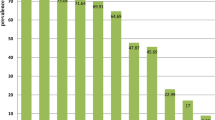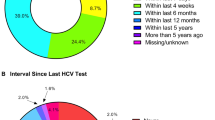Abstract
Currently, the Centers for Disease Control and Prevention recommends that persons between 15 and 64 years get tested for human immunodeficiency virus (HIV) at least once in their lifetime and persons with HIV risk factors get tested more frequently. There is limited research examining factors associated with never testing for HIV among non-Hispanic Black men in the United States. The purpose of this study was to examine the prevalence of never testing for HIV, reasons for never testing for HIV, and correlates of never testing for HIV. We analyzed 2011–2013 National Survey of Family Growth data and restricted analyses to male respondents aged 15–44 years who self-identified as being non-Hispanic Black. Logistic regression models estimated adjusted prevalence ratios (APR) assessing the association between socio-demographic and behavioral factors and never testing for HIV. An estimated 31.2 % of non-Hispanic Black males aged 15–44 years have never been tested for HIV. Non-Hispanic Black men aged 15–17 years (APR 4.45; 95 % CI 2.88–6.87) or 18–24 years (APR 1.94; 95 % CI 1.21–3.13), who did not visit a doctor or healthcare provider (APR 1.43; 95 % CI 1.10–1.86), or did not report any sexual risk behaviors in the past 12 months (APR 1.83; 95 % CI 1.34–2.51) were more likely to never test for HIV compared to their respective counterparts. Continued expansion of HIV testing initiatives and prevention programs that focus on non-Hispanic Black men is critical to addressing HIV-related health disparities and the public health burden of HIV in this population.
Similar content being viewed by others
References
Centers for Disease Control and Prevention. Diagnoses of HIV infection in the United States and dependent areas, 2014, vol. 26. Available at http://www.cdc.gov/hiv/pdf/library/reports/surveillance/cdc-hiv-surveillance-report-us.pdf Accessed 10 Feb 2016.
Centers for Disease Control and Prevention. Leading causes of death in Males, United States Available at http://www.cdc.gov/men/lcod/ Accessed 24 June 2015.
Maulsby C, Millett G, Lindsey K, et al. HIV among black men who have sex with men (MSM) in the United States: a review of the literature. AIDS Behav. 2014;18(1):10–25.
Bowleg L, Raj A. Shared communities, structural contexts, and HIV risk: prioritizing the HIV risk, and prevention needs of Black heterosexual men. Am J Public Health. 2012;102(S2):S173–7.
Bowleg L, Burkholder GJ, Massie JS, et al. Racial discrimination, social support, and sexual HIV risk among Black heterosexual men. AIDS Behav. 2013;17(1):407–18.
Reed E, Santana MC, Bowleg L, et al. Experiences of racial discrimination and relation to sexual risk for HIV among a sample of urban black and African American men. J Urban Health. 2013;90(2):314–22.
Wejnert C, Le B, Rose CE, et al. HIV infection and awareness among men who have sex with men–20 cities, United States, 2008 and 2011. PLoS One. 2013;8(10):e76878.
National HIV/AIDS Strategy. July 2010. Available at https://www.whitehouse.gov/sites/default/files/uploads/NHAS.pdf Accessed 10 May 2015.
Centers for Disease Control and Prevention. HIV testing in clinical settings. Available at http://www.cdc.gov/hiv/testing/clinical/ Accessed 24 June 2015.
Ebrahim SH, Anderson JE, Weidle P, et al. Race/ethnic disparities in HIV testing and knowledge about treatment for HIV/AIDS: United States, 2001. AIDS Patient Care STDs. 2004;18(1):27–33.
Murray K, Oraka E. Racial and ethnic disparities in future testing intentions for HIV: US, 2007–2010: results from the National Health Interview Survey. AIDS Behav. 2014;18(7):1247–55.
Gardner EM, McLees MP, Steiner JF, et al. The spectrum of engagement in HIV care and its relevance to test-and-treat strategies for prevention of HIV infection. Clin Infect Dis. 2011;52(6):793–800.
Skarbinski J, Rosenberg E, Paz-Bailey G, et al. Human immunodeficiency virus transmission at each step of the care continuum in the US. JAMA Intern Med. 2015;175(4):588–96.
Ojikutu B, Nnaji C, Sithole J, et al. All black people are not alike: differences in HIV testing patterns, knowledge, and experience of stigma between US-born and non–US-born blacks in Massachusetts. AIDS Patient Care STDs. 2013;27(1):45–54.
Bogart LM, Derose KP, Kanouse DE, et al. Correlates of HIV testing among African American and Latino church congregants: the role of HIV stigmatizing attitudes and discussions about HIV. J Urban Health. 2015;92(1):93–107.
Doshi RK, Malebranche D, Bowleg L, et al. Health care and HIV testing experiences among Black men in the South: implications for “Seek, Test, Treat, and Retain” HIV prevention strategies. AIDS Patient Care STDs. 2013;27(2):123–33.
Lepkowski JM, Mosher WD, Davis KE, et al. National Survey of Family Growth, Cycle 6: sample design, weighting, imputation, and variance estimation. Vital Health Stat. 2006;2(142):1–82.
National Center for Health Statistics (U.S.). Responsive design, weighting, and variance estimation in the 2006–2010 National Survey of Family Growth. Hyattsville: U.S. Dept. of Health and Human Services, Centers for Disease Control and Prevention, National Center for Health Statistics; 2013.
Lepkowski JM, Mosher WD, Groves RM, et al. Responsive design, weighting, and variance estimation in the 2006–2010 National Survey of Family Growth. Vital Health Stat. 2013;2(158):1–52.
Branson BM, Handsfield HH, Lampe MA, et al. Revised recommendations for HIV testing of adults, adolescents, and pregnant women in health-care settings. J Natl Med Assoc. 2008;100(1):131–47.
Lau JS, Adams SH, Irwin CE, Ozer EM. Receipt of preventive health services in young adults. J Adolesc Health. 2013;52(1):42–9.
Robinson KT, Sanders SA, Boyd JL. High-risk HIV minorities in the United States: Who gets tested and where? Am J Health Behav. 2012;36(3):348–59.
Talib HJ, Silver EJ, Coupey SM, et al. The influence of individual, partner, and relationship factors on HIV testing in adolescents. AIDS Patient Care STDs. 2013;27(11):637–45.
Arnold EA, Rebchook GM, Kegeles SM. ‘Triply cursed’: racism, homophobia and HIV-related stigma are barriers to regular HIV testing, treatment adherence and disclosure among young Black gay men. Cult Health Sex. 2014;16(6):710–22.
Valdiserri RO. Mapping the roots of HIV/AIDS complacency: implications for program and policy development. AIDS Educ Prev. 2004;16(5):426–39.
Petroll AE, DiFranceisco W, McAuliffe TL, et al. HIV testing rates, testing locations, and healthcare utilization among urban African-American men. J Urban Health. 2009;86(1):119–31.
Swenson RR, Rizzo CJ, Brown LK, et al. Prevalence and correlates of HIV testing among sexually active African American adolescents in four US cities. Sex Transm Dis. 2009;36(9):584.
Carter MW, Kraft JM, Hatfield‐Timajchy K, et al. STD and HIV testing behaviors among black and Puerto Rican young adults. Perspect Sex Reprod Health. 2011;201143(4):238–46.
Marks G, Crepaz N, Senterfitt JW, et al. Meta-analysis of high-risk sexual behavior in persons aware and unaware they are infected with HIV in the United States: implications for HIV prevention programs. JAIDS J Acquir Immune Defic Syndr. 2005;39(4):446–53.
Nunn A, Zaller N, Cornwall A, et al. Low perceived risk and high HIV prevalence among a predominantly African American population participating in Philadelphia’s rapid HIV testing program. AIDS patient care STDs. 2011;25(4):229–35.
Nyblade L, Stangl A, Weiss E, Ashburn K. Combating HIV stigma in health care settings: what works? J Intern AIDS Soc. 2009;12(1):15.
Abara W, Coleman JD, Fairchild A, et al. A faith-based community partnership to address HIV/AIDS in the southern United States: implementation, challenges, and lessons learned. J Relig Health. 2015;54(1):122–33.
Obermeyer CM, Osborn M. The utilization of testing and counseling for HIV: a review of the social and behavioral evidence. Am J Public Health. 2007;97(10):1762.
United States Preventive Services Task Force. Human Immunodeficiency Virus (HIV) Infection: Screening. Available at http://www.uspreventiveservicestaskforce.org/Page/Document/UpdateSummaryFinal/human-immunodeficiency-virus-hiv-infection-screening?ds=1&s=HIV. Accessed 21 Feb 2016.
Abara W, Heiman HJ. The Affordable Care Act and low-income people living with HIV: looking forward in 2014 and beyond. J Assoc Nurses AIDS Care. 2014;25(6):476–82.
Conserve D, King G, Turo A, Wafula E. Cigarette smoking and alcohol use as predictors of HIV testing in the United States: Results from the 2010 National Health Interview Survey. AIDS Care. 2014;26(7):842–9.
Acknowledgments
This study was supported by a training grant from the National Institute of Health, National Institute of Allergy and Infectious Diseases (T32 AI007001).
Author information
Authors and Affiliations
Corresponding author
Ethics declarations
Conflict of Interest
Donaldson F. Conserve has received training grant support from the National Institute of Health, National Institute of Allergy and Infectious Diseases and has no conflict of interest. Emeka Oraka declares that he has no conflict of interest. Winston E. Abara declares that he has no conflict of interest. Edith Wafula declares that she has no conflict of interest. Angela Turo declares that she has no conflict of interest.
Ethical Approval
This article does not contain any studies with human participants or animals performed by any of the authors.
Rights and permissions
About this article
Cite this article
Conserve, D.F., Oraka, E., Abara, W.E. et al. Correlates of Never Testing for HIV Among Non-Hispanic Black Men in the United States: National Survey of Family Growth, 2011–2013. AIDS Behav 21, 492–500 (2017). https://doi.org/10.1007/s10461-016-1452-4
Published:
Issue Date:
DOI: https://doi.org/10.1007/s10461-016-1452-4




